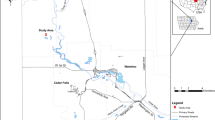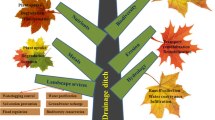Abstract
Increased water use associated with rapid growth in the Las Vegas Valley has inadvertently led to the creation of unique wetland systems in Southern Nevada with an abundance of biological diversity. Constructed and naturally created wetlands in the Las Vegas Valley watershed were studied to characterize and understand their potential role for improving ecosystem services (i.e., water purification). Nutrient and metal removal was assessed at four sites including a natural urban runoff wetland, a constructed urban runoff wetland, a constructed wastewater wetland, and a natural urban runoff/wastewater wetland. Plant nutrient uptake was dependent on ambient nutrient concentrations in water and sediments of specific wetlands, irrespective of the type of plants present. Phosphorus was mostly concentrated in below-ground plant parts whereas nitrogen was concentrated in above-ground parts. As for metalloids, bulrushes were more efficient than cattails at taking up arsenic and selenium. Averaging all the wetland sites and plant species, total nitrogen, phosphorus, arsenic and selenium removal was 924.2, 61.5, 0.30, and 0.38 kg/ha/year, respectively. Our findings suggest that natural and created wetland systems can improve water quality in the Las Vegas Valley watershed for some common pollutants, however, other measures are still needed to improve water quality below regulatory thresholds.
Similar content being viewed by others
References
Acharya, K., Kyle, M., & Elser, J. (2004). Effects of stoichiometric dietary mixing on Daphnia growth and reproduction. Oecologia, 138, 333–340.
APHA (2005). Standard methods for the examination of water and wastewater. American Public Health Association/Water Environment Federation, Washington D.C.
Brix, H. (1997). Do macrophytes play a role in constructed treatment wetlands? Water Science and Technology, 35, 11–17.
Cardwell, A. J., Hawker, D. W., & Greenway, M. (2002). Metal accumulation from aquatic macrophytes from southeast Queensland, Australia. Chemosphere, 48, 653–663.
Cizdziel, J. V., & Zhou, X. (2005). Sources and concentrations of mercury and selenium in compartments within the Las Vegas Wash during period of rapid change. Environmental Monitoring and Assessment, 107, 81–99.
Cronk, J. K., & Fennessy, M. S. (2001). Wetland plants: Biology and ecology. Florida: Lewis, Boca Raton.
Drizo, A., Frost, C. A., Grace, J., & Smith, K. A. (2000). Phosphate and ammonium distribution in a pilot-scale constructed wetland with horizontal subsurface flow using shale as a substrate. Water Research, 39, 2438–2490.
Eckberg, J. R., & Shanahan, S. A. (2009). Las Vegas wash vegetation monitoring report, 2008. Southern Nevada Water Authority, Las Vegas, Nevada.
Fox, P. M., & Doner, H. E. (2003). Accumulation, release and solubility of arsenic, molybdenum, and vanadium in wetland sediments. Journal of Environmental Quality, 32, 2428–2435.
Greenway, M. (2003). Suitability of macrophytes for nutrient removal from surface flow constructed wetlands receiving secondary treated sewage effluent in Queensland, Australia. Water Science and Technology, 48, 121–128.
Greenway, M. (2005). The role of constructed wetlands in secondary effluent treatment and water reuse in subtropical and arid Australia. Ecological Engineering, 25, 501–509.
Greenway, M., & Woolley, A. (2001). Changes in plant biomass and nutrient removal over 3 years in a constructed wetland in Cairns, Australia. Water Science and Technology, 44, 303–320.
Hamilton, S. J. (2004). Review of selenium toxicity in the aquatic food chain. Science of the Total Environment, 326, 1–3.
Hansen, D., Duda, P. J., Zayed, A., & Terry, N. (1998). Selenium removal by constructed wetlands: Role of biological volatilization. Environmental Science and Technology, 32, 591–597.
Kadlec, R. H., & Wallace, S. D. (2009). Treatment wetlands (2nd ed.). Florida: CRC, Boca Raton.
Klomjek, P., & Nitisoravut, S. (2005). Constructed treatment wetland: A study of eight plant species under saline conditions. Chemosphere, 5, 585–593.
Leising, J. F. (2003). Dye traces help quantify flow at Las Vegas wash. Southwest Hydrology, 2, 8–9.
Lesage, E., Rousseau, D. P. L., Meers, E., Van de Moortel, A. M. K., Du Laing, G., Tack, F. M. G., et al. (2007). Accumulation of metals in the sediment and reed biomass of a combined constructed wetland treating domestic wastewater. Water, Air, and Soil Pollution, 183, 253–264.
Lin, Z., & Terry, N. (2003). Selenium removal by constructed wetlands: Quantitative importance of biological volatilization in the treatment of selenium-laden agricultural drainage water. Environmental Science and Technology, 3, 606–615.
LVWCC (2009). What is being done? Las Vegas wash coordinating committee website. Available via http://www.lvwash.org. Accessed 19 Dec 2009.
Mitsch, W. J., & Gosselink, J. G. (2000). Wetlands. New York: Wiley.
Pollard, J., Cizdziel, J., Stave, K., & Reid, M. (2007). Selenium concentrations in water and plant tissues of a newly formed arid wetland in Las Vegas, Nevada. Environmental Monitoring and Assessment, 135, 447–457.
Reddy, K. R., & DeBusk, W. F. (1987). Nutrient storage capabilities of aquatic and wetland plants. In: K. R. Reddy, & W. H. Smith (Eds.), Aquatic plants for water treatment (pp. 337–357). Orlando, Florida: Magnolia.
Richardson, C. J., & Vymazal, J. (2000). Sampling macrophytes in wetlands. In: R. B. Rader, D. P. Barter, & S. A. Wissinger (Eds.), Bioassessment and management of North American freshwater wetlands (pp. 297–337). New York: Wiley.
Schwartz, M. E., & Boyd, C. E. (1995). Constructed wetlands for treatment of channel catfish pond effluents. The Progressive Fish-Culturist, 57, 255–266.
Seiler, R. L., Skorupa, J. P., Naftz, D. L., & Nolan, B. T. (2003). Irrigation-induced contamination of water, sediment, and biota in the Western United States: Synthesis of data from the national irrigation water quality program. USGS Professional Paper 1655.
SNWA (2010). What is the “Wash”? Las Vegas Wash Coordination Committee, Las Vegas, Nevada. Available via http://www.lvwash.org/wash/main. Accessed 15 Jan 2010.
Sterner, R. W., & Elser, J. J. (2002). Ecological stoichiometry: The biology of elements from molecules to the biosphere. Princeton University Press, Princeton, NJ.
Tanner, C. C. (2001). Growth and nutrient dynamics of soft-stem bulrush in constructed wetlands treating nutrient-rich wastewaters. Wetlands Ecology and Management, 9, 49–73.
Thullen, J. S., Sartoris, J. J., & Nelson, S. M. (2005). Managing vegetation in surface-flow wastewater treatment wetlands for optimal treatment performance. Ecological Engineering, 25, 583–593.
Toet, S., Bouwman, M., Cevaal, A., & Verhoeven, J. (2005). Nutrient removal through autumn harvest of Phargmites australis and Typha latifolia shoots in relation to nutrient loading in a wetland system used for polishing sewage treatment plant effluent. Journal of Environmental Science and Health, 40, 1133–1156.
USEPA (2000). Constructed wetlands treatment of municipal wastewaters, EPA 625/r-99/010. USEPA Office of Research and Development, Washington DC.
USEPA (2001). Determination of trace elements in waters and wastes by inductively coupled plasma mass spectrophotometry, method 7473, U.S. Environmental Protection Agency, Washington DC.
USEPA (2004). Water quality criteria, ambient aquatic life, selenium. U.S. Environmental Protection Agency, Washington DC.
USGS (2010). Surface–Water Annual Statistics for the Nation. United state Geological Survey. Available via http://waterdata.usgs.gov/nwis/annual. Accessed 18 Jan 2010.
Vymazal, J. (2006). Constructed wetlands with emergent macrophyte: From experiments to a high quality treatment technology. In: V. Dias, & J. Vymazal (Eds.), In Proceedings of the 10th international conferences on wetland systems for water pollution control (pp. 3–27). Lisbon, Portugal.
Vymazal, J. (2007). Removal of nutrients in various types of constructed wetlands. Science of The Total Environment, 380, 45–65.
Vymazal, J., Brix, H., Cooper, P. F., Green, M. B., & Haberl, R. (1998). Constructed wetlands for wastewater treatment in Europe. Backhuys, Leiden, The Netherlands.
Vymazal, J., Krása, P. (2005). Heavy metals budget for constructed wetland treating municipal sewage. In: J. Vymazal (Ed.), Natural and constructed wetlands: Nutrients, metals and management (pp. 135–142). Backhuys, Leiden, The Netherlands.
Vymazal, J., Kröpfelová, L., Švehla, J., Chrastny, V., & Štíchová, J. (2009). Trace elements in Phragmites australis growing in constructed wetlands for treatment of municipal wastewater. Ecological Engineering, 35, 303–309.
Zhang, Y., & Moore, J. N. (1997). Reduction potential of selenate in wetland sediment. Journal of Environmental Quality, 32, 910–916.
Zhang, Z., Rengel, Z., & Meney, K. (2007). Interactive effects of nitrogen and phosphorus loadings on nutrient removal from simulated wastewater using Schoenoplectus validus in wetland microcosms. Chemosphere, 72, 1823–1828.
Zhou, X., Roefer, P., & Zikmund, K. (2004). Las Vegas wash monitoring and characterization study: Results for water quality in the wash and tributaries. Final Report 2004, Southern Nevada Water Authority, Las Vegas, Nevada.
Zhou, X., & Van Dooremolen, D. M. (2004). Demonstration wetlands study in the city of Henderson water reclamation facility. Final Report 2007, Southern Nevada Water Authority, Las Vegas, Nevada.
Author information
Authors and Affiliations
Corresponding author
Rights and permissions
About this article
Cite this article
Adhikari, A.R., Acharya, K., Shanahan, S.A. et al. Removal of nutrients and metals by constructed and naturally created wetlands in the Las Vegas Valley, Nevada. Environ Monit Assess 180, 97–113 (2011). https://doi.org/10.1007/s10661-010-1775-y
Received:
Accepted:
Published:
Issue Date:
DOI: https://doi.org/10.1007/s10661-010-1775-y




